Considering his record of 204 games in La Liga, scoring 58 goals and providing 45 assists for Barcelona. Plus 29 goals and 18 assists in 137 EPL appearances for Chelsea – Pedro is not one of the very best players of the recent 15 years, but indeed one of the most consistent ones.
He is the only player in history to win the UEFA Champions League, UEFA Europa League, UEFA Supercup, FIFA Club World Cup, FIFA World Cup and UEFA European Championship. As this magazine article is written, Pedro played his final game for Chelsea in the FA Cup final against Arsenal, where he got injured. It has already been official for some time that he will not renew his contract with the Blues, which expires this summer.
However, it is at the moment this text has not official yet if he will join Roma, even though the signs are clear. Therefore, the Italian club's coach Paulo Fonseca will get another winger. In this tactical analysis and scout report, we will look at the tactics of Roma, the style of play of Pedro and the other wingers who are currently at the Italian club as well as a data analysis on Roma to see how Pedro will fit in at his new club.
The wingers’ role under Fonseca
For most of the campaign, the Portuguese coach used a 4-2-3-1 formation while towards the end of the season he often lined his team up in a 3-4-3 formation. However, the positioning and formation of the players during the build-up was in both cases the same.
This season Roma was among the teams in Serie A who preferred to dominate the game. Fonseca’s side had, on average 54.5% of possession, which is the fifth-highest value in the league. Furthermore, they played on average 4.47 passes per possession phase which is also one of the top values in the league. This shows that they use mainly a calm and structured build-up with short passes.
When in possession they frequently used a 3-2-4-1 formation which was easily created with the 4-2-3-1 as one defensive midfielder dropped between the centre-backs, the ’10’ dropped next to the other defensive midfielder, the wingers tucked in, and the full-backs pushed forward to be level with the wingers.
On some occasions also only one wide defender positioned higher while the other stayed deep to create the back three with the two centre-backs. The double-pivot then stayed in position, and only one winger tucked in to give the full-back space on the wing while the opposing one stayed wide.
When they played in a 3-4-3 as they mainly did in the last few games of the season, the wing-backs just moved forward, and the wingers tucked in to have again the 3-2-4-1. We can see an example for that in the final game of the season against Juventus. In this match, they played with a 3-4-3 which turned into the 3-2-4-1 in possession.
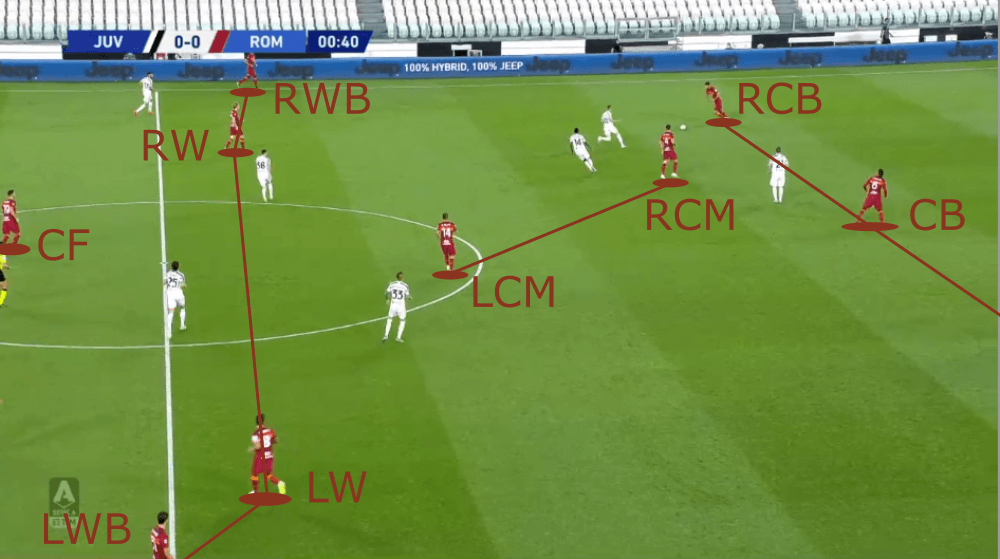
Fonseca used many different pairings on the wings. They had to be dynamic, considering they were mainly positioned in the half-spaces as we saw above, they also occasionally had the task to move wide and provide the necessary width.
One central task for them was to provide options for forward passes. Therefore, they often moved between the lines of the opposition to create passing lanes. In the shot below, we can see their 3-2-4-1 with one of the defensive midfielders in a slightly advanced position. However, the left centre-back is on the ball, and the left-winger Diego Perotti is positioned in the half-space to receive the ball between the lines.
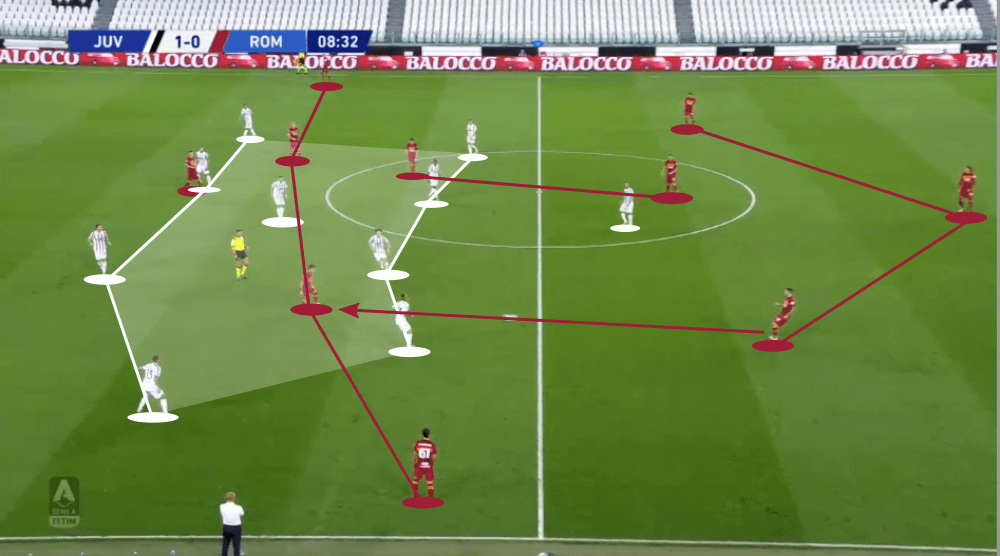
As I mentioned earlier in this tactical analysis, the wingers had to be variable, and additionally, the players also acted very differently in this position as they are entirely different types of players as we will see in the next section of this scout report.
The wingers at Roma
Diego Perotti – The winger from Argentina is already since 2016 at the club and prefers to play on the left side as he then cuts in to have the ball on his dominant right foot. At 32-years-old, he is the oldest player among the wingers. Still, he has a lot of quality as he is clever when it comes to detecting free spaces to open up passing lanes, and has the technical abilities to find solutions under pressure. Due to that, he also feels comfortable to position himself in the half-space as he has such decent ball control to create something even under direct pressure from the opposition.
Justin Kluivert – The 21-year-old Dutchman played in the recent season about 1600 minutes in the Serie A and is besides Cengiz Ünder and Nicolò Zaniolo, the most promising talent in the whole squad. He prefers to be positioned on the left side but can play on either wing. As he is right-footed, he likes to drift inside from the left-wing while on the right side; he prefers to stay wide. Other than Perotti, he is not a player who receives the ball deeper as he is more active in the final third and makes deep runs. The 21-year-old is a very direct player but has still a lot more to come.
Carles Pérez – The Spaniard joined Roma on loan for this past season and will move to them on a permanent deal in this summer from Barcelona. He is probably the weakest winger in the side (except the 21-year-old Mirko Antonucci who returns in this summer from his loan). Pérez prefers to play on the right side where he sometimes stays wide but mainly is positioned in the half-space. From there, he starts either diagonal runs behind the last line of defence or comes deeper to support his teammates. He is reliable under pressure due to his ball control, but also often picks out his teammates with great passes. However, he has to work on his finishing as he often creates valuable situations for himself, but often fails to take them.
Nicolò Zaniolo – The 21-years-old Italian is in truth more of an offensive midfielder or striker, but also played in this season as a winger, showing his variability. He prefers to play on the left side as he is mainly positioned in the right half-space. From there, he can dribble to the inside to either pick out a teammate with a through pass, or go direct to goal. He scored six goals this past season and provided two assists showing that he is able to be a vital part in the offence, considering he had to fight back from injury. Also, he is powerful on the ball and intelligently uses his body to get himself between the opponent and the ball if necessary.
Cengiz Ünder – The Turkish winger prefers to play on the right side as he cuts in from there to have the ball on his left foot. He is more of a natural winger who stays near the touchline. He had to battle through injury this past season restricting him to only 18 appearances in the 2019/20 season. However, he is a very dynamic and direct player with great ball control and a powerful shot. He is besides Zaniolo the player who will be in the upcoming years the star of the team as long as they both stay healthy.
Henrikh Mkhitaryan – The Armenian already played in the Bundesliga for Dortmund and in the EPL for Manchester United and Arsenal showing his experience. He is only loaned out from the Gunners and will return to them this summer. Mkhitaryan can play as an offensive midfielder and as a left-winger. When he plays out wide, he logically prefers to position more centrally to utilise his technical abilities and understanding of the game. He also had several injuries this season but still managed to score nine goals in 22 appearances in Serie A, showing his goal threat. It will be interesting to see if they can bring him in on a permanent deal after this loan spell.
Pedro’s style of play
Now, as we look now at the type of wingers which are currently in the squad of Roma, we will have a short analysis of Pedro to see what he will bring to his new team. First of all, I have to note that the Spaniard fits well into the tactics of the Portuguese head coach due to his variability.
Pedro played as an inverted winger or central player for Chelsea to use his dribbling and passing skills to generate high-value attacks. Due to his long time at Barcelona, the 33-year-old has an incredible understanding of the game and detects free spaces very quickly for a winger. In the following situation, the Spaniard is on the ball in the centre even though he is lined up as winger and notices the deep run of his teammate Mason Mount. He finds the young Englishman with a great through pass, which leads to a dangerous attack.
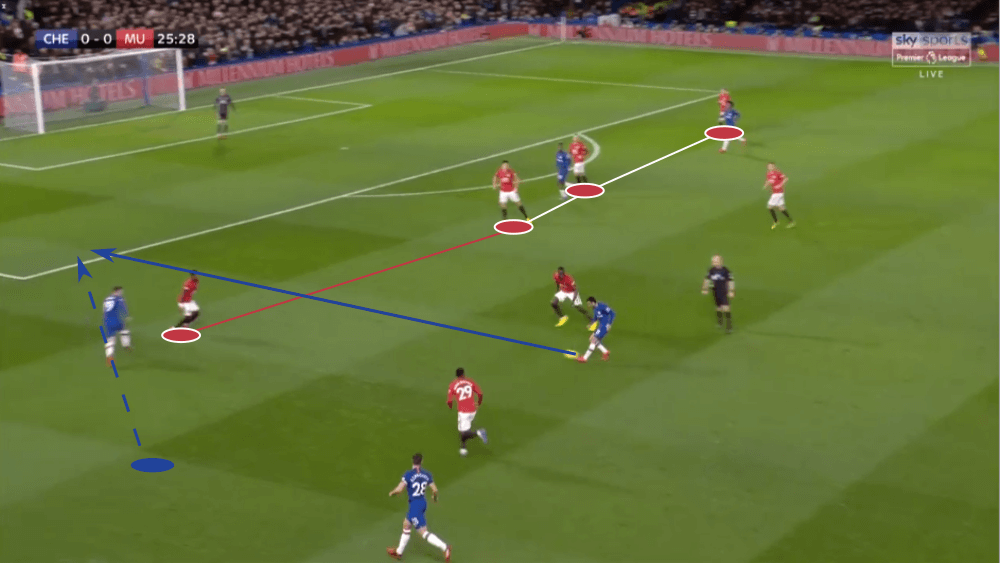
However, back then when he was at Barcelona, one of his central tasks as a winger was to provide the width and stay near the touchline. The Spaniard plays very well in central areas of the pitch as we saw above, but still, he also likes to be in the wide-areas as we can see in the example below. At Chelsea, this sometimes caused problems when he did so on the left-wing since the left-back Marcos Alonso was permanently positioned high and therefore they occupied the same space as we can see below.
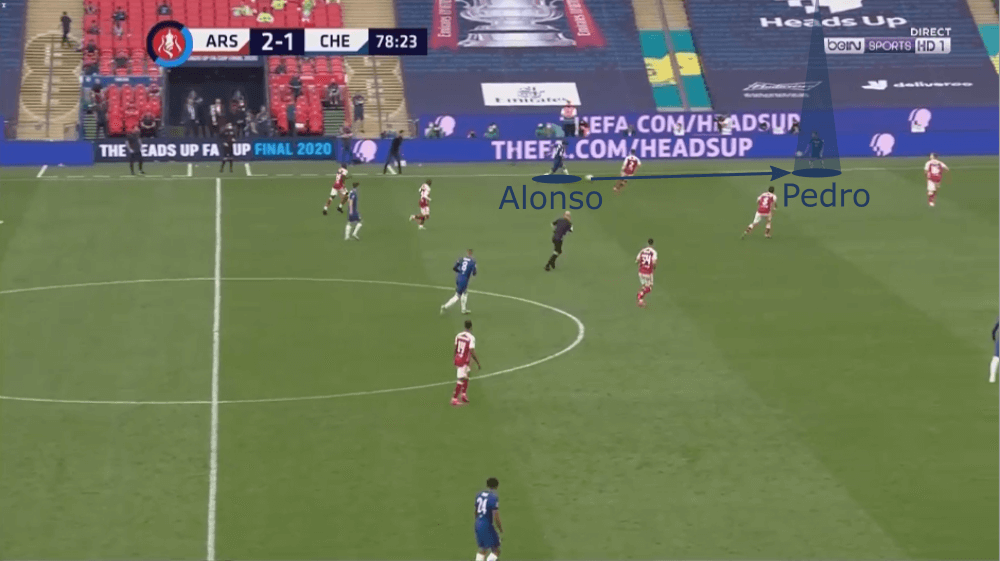
Another great strength of Pedro is that he is confident with both feet which makes it hard for his opponents to defend against him. While some wingers have the tendency to execute almost all shots and crosses with their strong foot which makes their actions predictable, Pedro can shoot and cross with both feet. Considering this, he can cut in or go down the wing on both sides since in every situation he can shoot and cross.
In the shot below, we can see an in-game example as he dribbles towards his opponent who expects him to go down the line and cross as Olivier Giroud is in the box, but he cuts inside to play a good pass to Mount who scores.
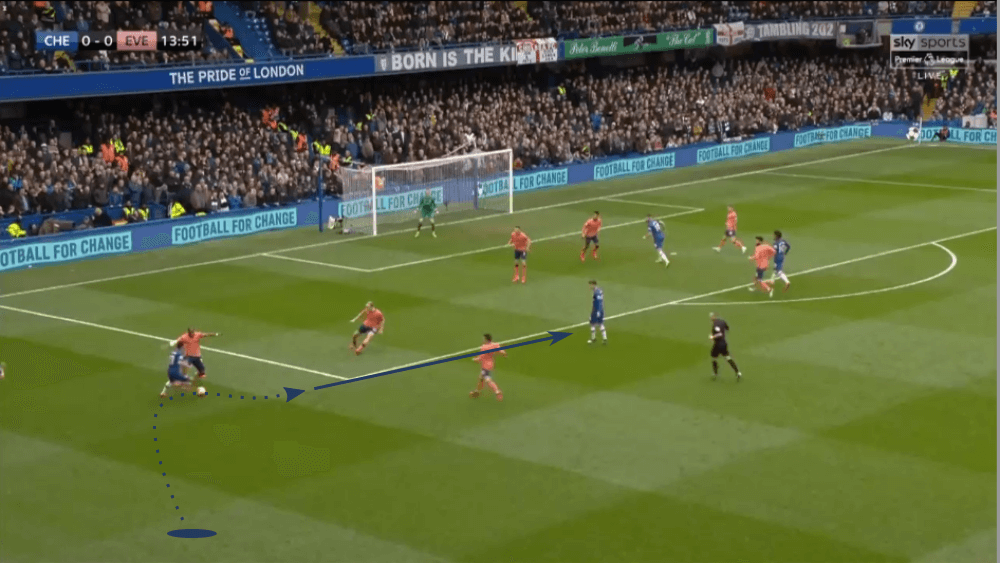
Pedro can play in the wide-areas as well as in more central spaces. This makes him very dynamic and the fact that he is confident with both feet gives him in several situations a lot of options.
Data analysis
In this final part of the scout report, before we do a final conclusion on the described aspects, we will have an additional look at some statistics. Until now, we talked about the tactics of the players on the pitch, but data analysis can always give us an additional view. However, in the following three graphs, the focus is once again more on the type of players and not the quality of them as Pedro is indeed not anymore one of the two best wingers at Chelsea, but on the level of Roma’s wingers.
In the following graphs, we have visualised the data of all Serie A and EPL wingers who played in the 2019/20 season at least 500 minutes in the respective league. The players of Chelsea are blue, Roma’s are orange, purple stands for the EPL and the green dots play in the Serie A. In the first graph, we look at the progressive actions of the wingers per 90 minutes.
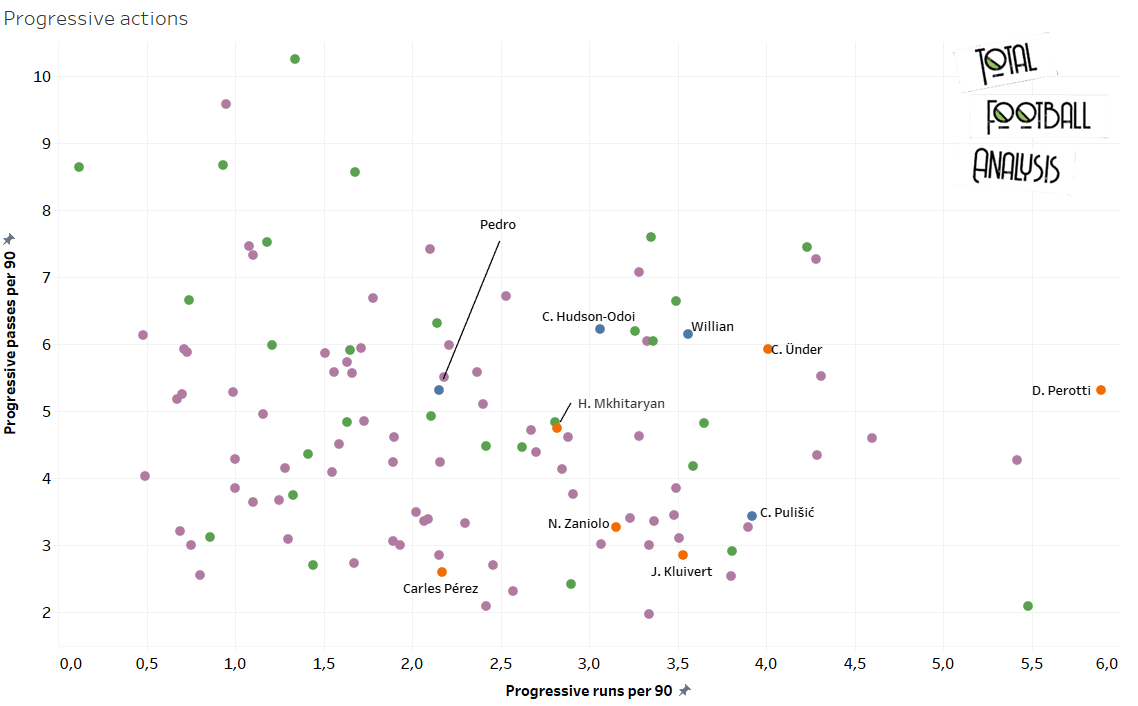
Perotti is with 5.89 the absolute best player in this pool when it comes to progressive runs while Pedro is the weakest one in this category compared to the other Chelsea and Roma wingers. However, he makes solid 5.32 progressive passes per 90 which is a decent value, showing that in the recent season his passing was more efficient than his dribbling.
Perotti has exactly the same value, and Ünder is with 5.92 the only winger at Roma with more progressive passes per 90 than Pedro. In the next graph, the numbers for expected goals (xG) per 90 and expected assists (xA) per 90 are visualised.
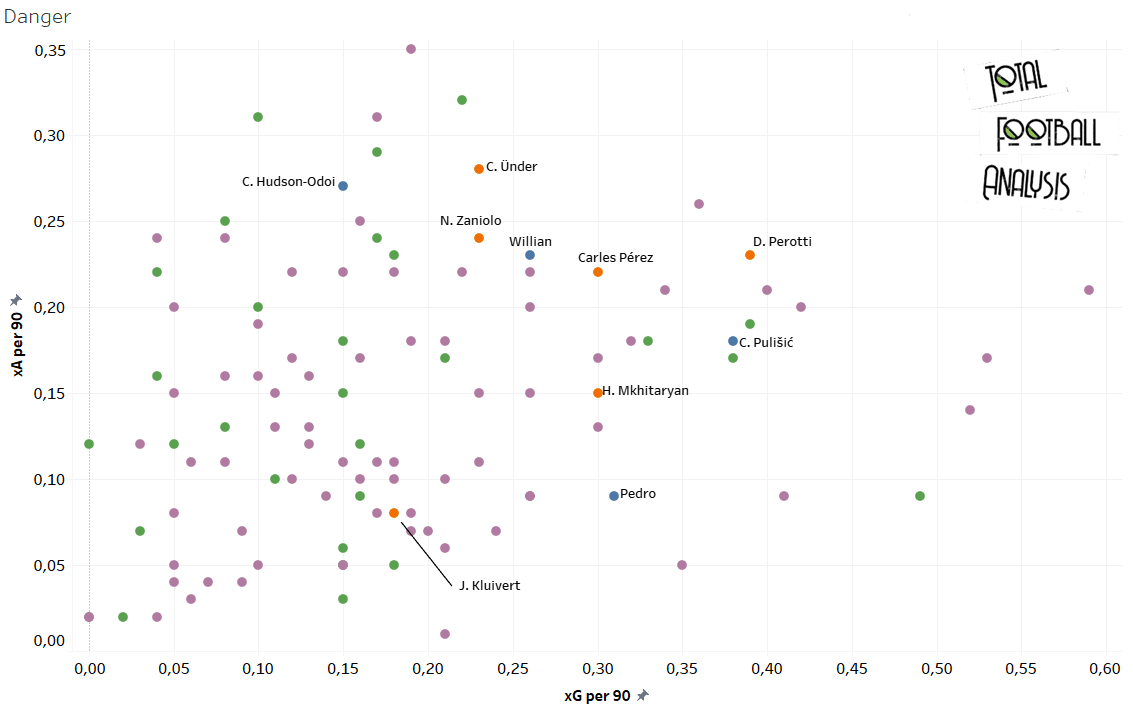
Kluivert is with 0.08 xA the only player of Roma and Chelsea with a lower value for this metric compared to Pedro (0.09). On the other side, the Spaniard has a decent xG value of 0.31 and is one of the best players of the two European top leagues in this category. Perotti is the Roma player with high numbers for both offensive metrics while Ünder has especially for xA with 0.28 a strong value.
These numbers show us that the 33-year-old doesn’t create that many goalscoring situations for his teammates, but more for himself. In the final graph, we look at the two passing statistics which can tell us a bit more in which areas he operates. We compare the players’ numbers of deep completions (passes in the final third) and the numbers of passes to the final third.
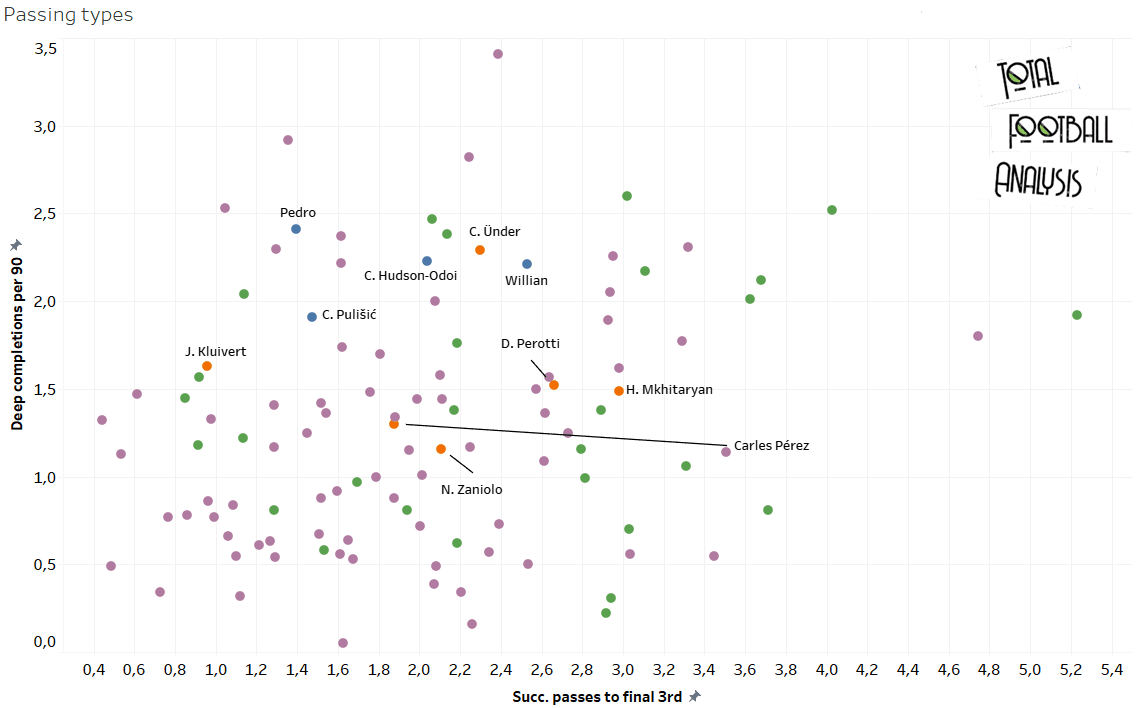
While Kluivert is the only player of Roma and Chelsea with a lower value for successful passes to the final third than Pedro, the 33-year-old Spaniard is the one with the deepest completions per 90 minutes with 2.41. This shows us that Pedro operates more in the final third than bringing the ball there compared to the other players. Without that much of a surprise, the Roma players have quite decent numbers for passes to the final third as they are often positioned deeper in the half-spaces to progress the ball from there.
Conclusion
Fonseca used many different wingers in different pairings this past season. Sometimes due to the numerous injuries, but he also rotated when there were several players fit and ready to compete. Ünder is probably the one who is most similar to Pedro, but without any doubt, the Spaniard gives them even an additional new option.
There is no one type of winger Fonseca uses in his tactics which is perfect for Pedro due to his variability. Considering this, the move of the 33-year-old makes sense for both sides as Pedro will likely get more time on the pitch compared to this season at Chelsea. Fonseca will now have one more option which makes his team more flexible.

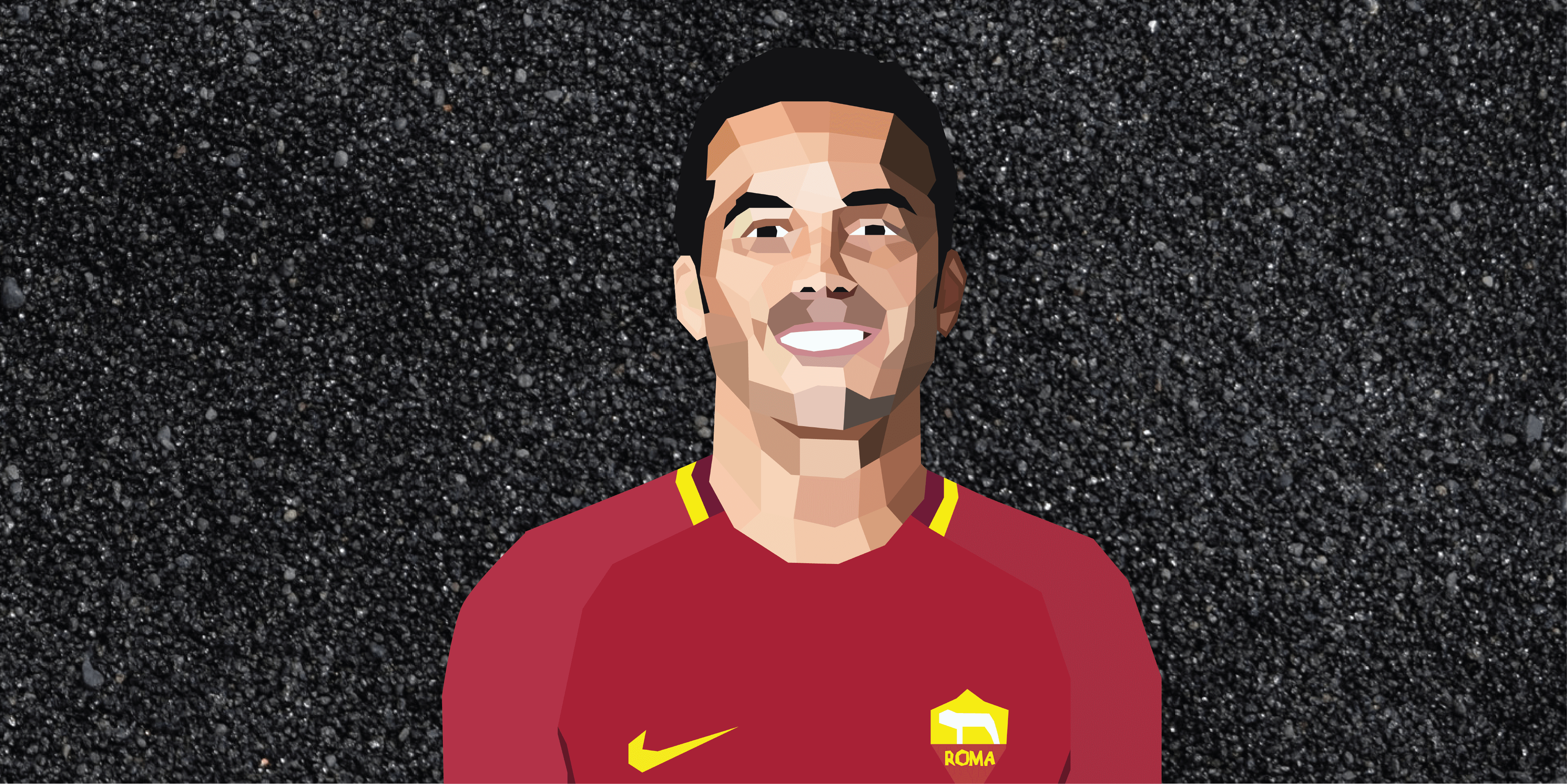



Comments